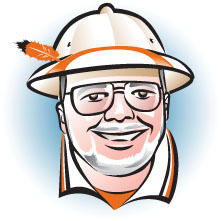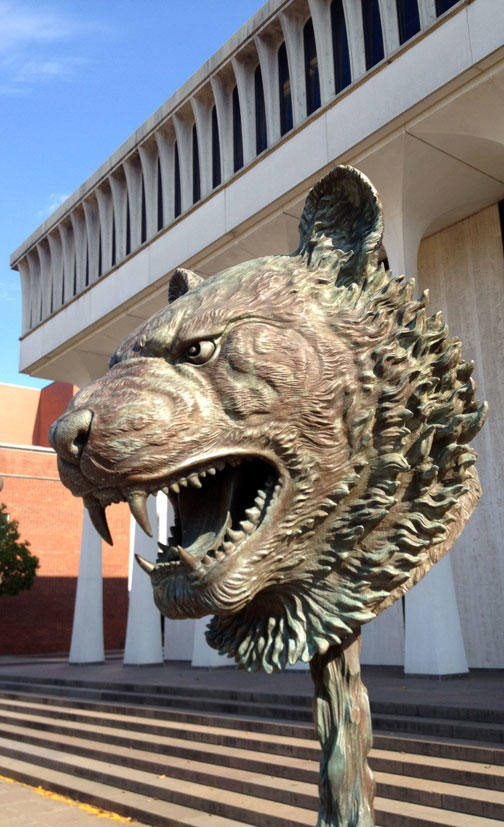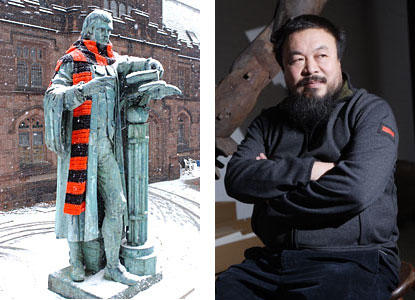Rally ’Round the Cannon: You say you want a revolution?

“You ask me for a contribution
Well, you know
We are doing what we can”
— John Lennon & Paul McCartney, “Revolution”
It’s an appropriate point, during the current malevolent campaign atmosphere here in the United States, to note that for a university, governmental politics is much better practiced as an academic discipline than a formalized activity. Princeton probably has done as well in this vein as any other institution, keeping lines of civility open in recent years thanks in part to the high- profile conversations between professors Robert George and Cornel West *80 ; but in terms of the institution formally aligning as an entity with any side in a political battle, it’s a sure lose-lose in a situation where government funding, donations of alums from across the political spectrum, and an array of international resources all play a key material role.
Which makes the current art exhibit on Scudder Plaza so fascinating. The “Circle of Animals/Zodiac Heads” of Ai Weiwei, lightning rod of Chinese unrest, is an intriguing step into the political for Princeton, despite its scrupulous trappings as an artistic exercise. You need to read about it , see it in the next year, consider the various underlying, unspoken elements – including a slam on the West’s treatment of China in the 19th century – and come to your own conclusions. (Beyond the Year of the Tiger piece; that of course will be a big local favorite, and quite inspiring when the Band takes its periodic dip in the fountain.) However, two things I will say regarding its political aspects: One, the artist will not be allowed by his government to attend the Oct. 10 symposium centered on the sculpture; and two, if you think this multi-ton work popped up on the plaza without the benevolent knowledge of the Princeton trustees, you are to call me immediately regarding your purchase of the Brooklyn Bridge, newly reinstalled across Lake Carnegie at Harrison Street.
There hasn’t been much highly political angst around Princeton in recent times – even during the invasion of Iraq. Before that, the University’s stance on investments in companies doing business in South Africa during apartheid was a chronic sore point with student groups for decades (PAW, March 27, 1978), but the trustees stayed removed as far as possible. As stockholders, they advised their holdings to follow the Global Sullivan Principles on corporate social responsibility, but they actually divested of only a single position.
You have to go back to Vietnam to find truly dark clouds overhanging the campus, and given the incendiary national mood, things were relatively calm even then. Despite President Robert Goheen ’40 *48’s transition from LBJ supporter in 1965 to bombing critic in 1967 to antiwar signatory in 1969, the trustees refused to take any position on the issue, and in fact when directly challenged approved an explicit statement that they were taking no stand. But those with a long memory recall both the on-campus disruption and conservative-alumni backlash at the time, and understand the dangers that lie in even the mistaken perception of political favoritism. Of course, it could have been far worse (see: Columbia, Cornell, Harvard) – in the prior decade, the University had hosted events featuring Alger Hiss, Fidel Castro, and Martin Luther King ; the lessons learned and public relations polished in those cases served the trustees and administration well during Vietnam.
World War I, World War II, and Korea (to a degree) are somewhat misleading cases: Public reaction was so overwhelming that if Princeton had not mobilized to the extent it did, it would have been politically incendiary, but going along was really not perceived to be a political stance as much as a patriotic imperative, especially given the overwhelmingly domestic nature of the student body.
The prior political paroxysm, the Civil War , was discussed in this column last year; it was hugely destructive to the psyche of the College, which beforehand had been far more Southern in scope than it’s ever been since. But although the faculty was unwavering in support of the Union, the trustees desperately wished to be spared: They deferred to their place in the North on a day-to-day operational basis, but their minutes grieved over a brutal war pitting alumnus against alumnus.
However, there is one clear exception to Princeton’s leave-the-politics-to-the-politicians approach that glares through the history books, and hardly a small one: the American Revolution. The day in 1768 that John Witherspoon stepped off the boat from Britain in Philadelphia and became enamored of the ethos and people of the colonies, the College was well on its way to revolutionary patriotism. The New Lights of the Enlightenment who had created the place 20 years earlier had recruited him as a clever ploy to avoid pressure from Old Light Presbyterians toward some sort of conciliatory president. He was a close follower of the most progressive Scots philosophers of his time (notably Francis Hutcheson ) and heavily suspicious of the Church of England, which was being handed more power in the Colonies. In revamping the College curriculum, he built in the individual responsibility and civic consciousness of the Great Awakening, and the results were such graduates as James Madison 1771, Aaron Burr Jr. 1772, and Philip Freneau 1771, the poet of the Revolution, as well as Witherspoon’s own role as a pivotal member of Congress from 1776 to 1782. The trustees’ minutes of the era are about as clear as you could imagine: The forces of the British, who were after all the legitimate rulers of the moment, were referred to simply as “the enemy.” Of course, Nassau Hall then was completely wiped out in the war (to be fair, there was more damage done by encamped Continental forces after the Battle of Princeton than by the British prior to it). But Witherspoon enlisted various government entities to help rebuild afterward, which would have been difficult without his standing in Congress.
What strikes me about that singular enthused institutional plunge into heavy-duty politics is why it happened: The religious Great Awakening that created Princeton, and its emphasis on the individual’s primacy and responsibility to God, aligned precisely with the revolutionary spirit declaring that “all men are created equal” (the argument over a possible causal relationship will probably continue long after you and I are gone). Americans were willing to go to war against the best army in the world on that account, and for all intents and purposes the trustees and Witherspoon bet the College on it. This cause (to me, anyway) is strikingly analogous to that of the current dissidents’ circumstance in China; the grim Tiananmen Square confrontation of 1989 (a latter-day Lexington?) shows starkly how dangerous that is, how serious the stakes really are. The contention of Ai Weiwei (this generation’s Freneau?):
“Freedom of speech implies the world isn’t defined. It is meaningful when people are allowed to see the world their way.”
could well be a paraphrase of Witherspoon’s congressional buddy Ben Franklin (a publisher of Great Awakening philosophers):
"Without Freedom of Thought, there can be no such thing as Wisdom; and no such thing as public Liberty, without Freedom of Speech."
So as we look at “Circle of Animals/Zodiac Heads,”it’s a bit tempting along with Mr. Ai’s artistry to consider the Princetonians of the American Revolution. In fact, their displeasure with George III and his empire, along with Ai’s toward his government, are both well-represented in the highly practical modern observation of John Lennon:
But if you go carrying pictures of Chairman Mao
You ain’t gonna make it with anyone anyhow.













No responses yet